India 1951 "Centeray of Geological Survey of India"
| <prev | back to index | next> |
| Issue Date | 13.01.1951 |
| ID | Michel: 218; Scott: 232; Stanley Gibbons: 334; Yvert et Tellier: 31; Category: pR |
| Design | |
| Stamps in set | 1 |
| Value | Anas 2- Stegodon ganesa |
| Emission/Type | commemorative |
| Places of issue | |
| Size (width x height) | 40mm x 30mm |
| Layout | |
| Products | FDC x4 - all personalized |
| Paper | watermarked |
| Perforation | 13 |
| Print Technique | Offset lithography, purple and black colors |
| Printed by | Security Printing Press, Nashik |
| Quantity | 8.000.000 |
| Issuing Authority | Indian Post |
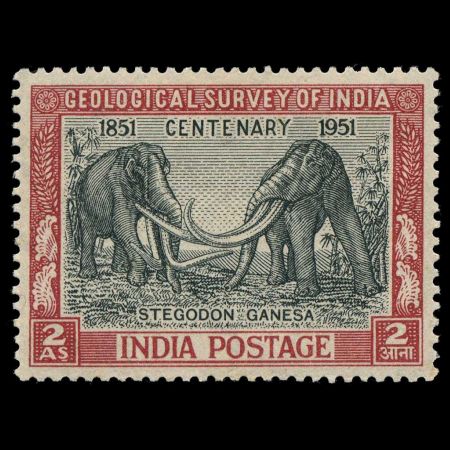
On the commemoration of the Centenary of the Indian Geological Survey on 13th January, 1951, the Indian Post released the stamp showing two individuals of Stegodon ganesa, the first ever reconstruction of a prehistoric animal on a stamp.
It was valued 2 Anas. Ana the olden Indian coin was in use before 1956. In 1956 Indian Government introduced the Paise the hundredth fraction of Rupee the currency. 16 Anas are equal to One Rupee.
 |
| 150th Anniversary of Geological Survey of India stamp of India from 2001, MiNr.: 1826, Scott: 1886. |

|
| Headquarters of Geological Survey of India, Jawaharlal Nehru road in Kolkata. Image credit: Wikimedia, Photographer: Pinakpani. |
On March 4th, 2001, another stamp was issued by the Department of Post, Government of India, to commemorate the 150 anniversary of Indian Geological Survey. This time, a geological motif was chosen instead. The four colour stamp shows bauxite (aluminium ore), chalcopyrite (copper ore) and psilomelane (manganese ore). The denomination of the stamp is 300 paise (Rs.3.00).
The image of the Stegodons on the stamp is reproduction of the illustration published by Henry Fairfield Osborn (an American paleontologist who was the president of the American Museum of Natural History) in "Proboscidea", as it was mentioned in the announcement of Indian Daily Mail from December 2nd 1950:
Postage Stamp To Mark Centenary Of Geological Survey Of India
NEW DELHI, Dev. l. —
A special postage stamp to mark the centenary of the Geological Surve of
India will be issued in January 1951, the Posts and Telegraphs Department.
The stamp, priced at two annas will be in Iwo colours, containing an
imprint of Stegodon Ganesa, an extinct species of fauna.
Stegodon Ganesa, a predecessor of the elephant, inhabited the forests
of the Himalayan foot-hills during
the Pilocene-Pleistocene Age, about 15 million years ago.
The animali which was huge in size, had massive
tusks nearly 10,5 feet in length and 2,25 feet in diameter at the base.
With the advent of the Ice Age in
the late Pioistocene Period, Stegodon
Ganesa became extinct giving Place
to the elephent after recession of glacial conditions.
Remains of these extinct animals
in various stages of preservation
have been unearthed from the Siwalink Hills.
The trustees of the American Natural History Museum
have kindly allowed the use of a drawing of Stegodon Ganesa,
which first appeared in one of their publications.

Stegodon Ganesa painted by Marget Flinsch under direction of Henry Fairfield Osborn, published as figure 755 in "Proboscidea : a monograph of the discovery, evolution, migration and extinction of the mastodonts and elephants of the world", by Henry Fairfield Osborn, Vol . 2, issued in New-York, USA in 1942. (biodiversitylibrary.org)
Stegodon ganesa
In 1928, a 3 metre long fossil tusk of an elephantine mammal Stegedon ganesa was found in India by Dr. Darashaw Nosherwan Wadia (October 25, 1883 - June 15, 1969) who pursued his personal research on stratigraphy, structure and palaeontology of the Kashmir Himalaya with single-minded devotion.Having a very keen eye for observation, he worked towards identification of broad structural elements of the NW Himalaya.
The fossil tusk is now kept at the Museum of the Geology Department of the Jammu University. The discovery of this skull, which was found in association with fossil ganoid fish and pteridospermous plants, led to the fixing of the age of an important geological rock formation in the Kashmir Himalaya.
Stegodons are primarily an Asiatic group of mammutid origin.
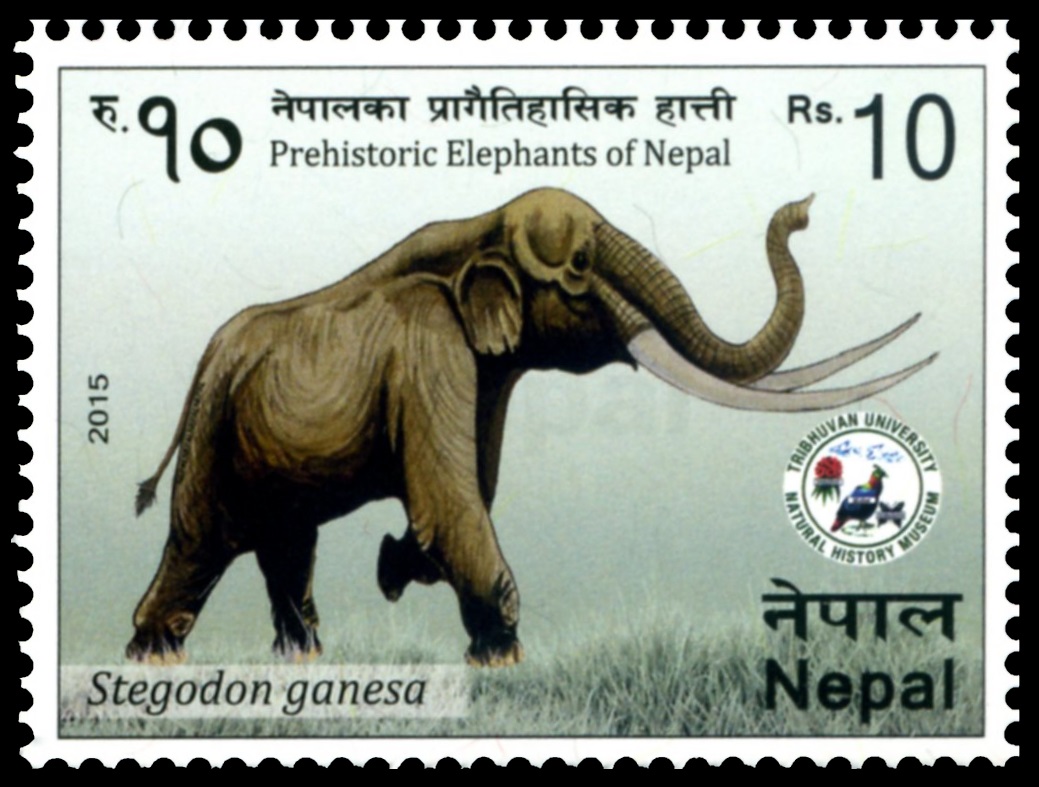 |
| Stegodon Ganesa on postage stamp of Nepal 2015, MiNr.: 1180, Scott: 983. |
Like elephants, Stegodons must have been good swimmers. Their fossils are frequently encountered on Asian islands, which even during periods of low sea-level (during the cold phases of the Pleistocene) were not connected by land bridges with the Asian continent. A general evolutionary trend in large mammals on islands is island dwarfism. The smallest dwarf species, Stegodon sondaari, known from 900,000 year old layers on the Indonesian island of Flores, had an estimated body weight of 300 kg, smaller than a water buffalo.
A medium to large sized stegodont, Stegodon florensis, with a body weight of about 850 kg, appeared about 850,000 years ago, and then also evolved into a dwarf form, Stegodon florensis insularis.
The latter was contemporaneous with the hominin discovered in 2003, Homo floresiensis, and disappeared about 12,000 years ago.
Stegodon tetrabelodon syrticus was a spectacular late Miocene species with four tusks described from a partial cranium and jaws found in North Africa.
Products and associated philatelic items
| The commemorative postmark of the Indian Geological Survey | FDC with commemorative postmark | |
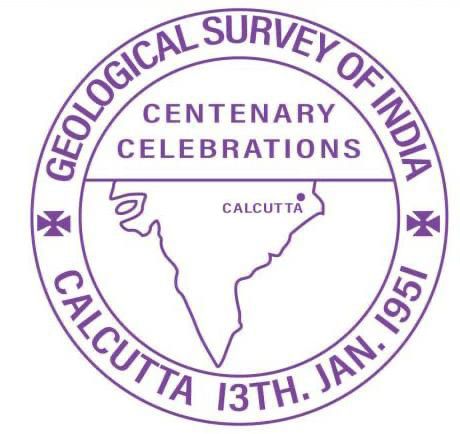 |
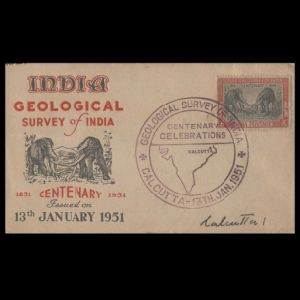 |
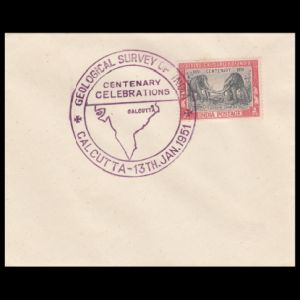 |
| FDC with regular postmark | ||
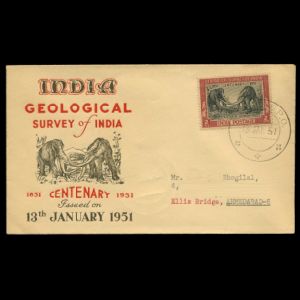 |
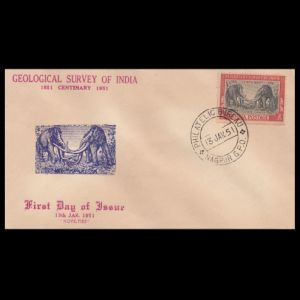 |
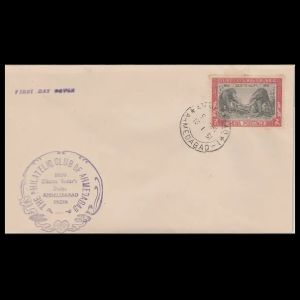 |
| Produced by Bombay Philatelic Company | Produced by Novelties Company | Produced by the Philatelic Club of Ahmedabad |
| Example of Circulated Covers | ||
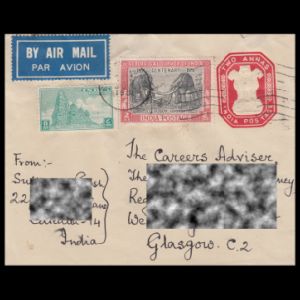 |
 |
|
|
The letter was cancelled with "Experimental P.O." An experimental Post Office is opened for a period of 6 months in an area where it appears services are needed. If it gets enough business, it becomes permanent. If it does not, it can be extended up to 2 years before it is made permanent or closed. |
||
References

|
- Technical details annoucements and official press release:
Colnect, NespaperSG (Indian Daily Mail from December 2nd 1950). - FDC variations:
Air India First Flight Covers & Maya Philately (the article does not exist anymore) - Articels about the stamp:
- A philatelic first (India 1951), by Peter A. Austen
- Stegodons:
Wikipedia, The Paleontological Society of India (vol 49),- "Proboscidea : a monograph of the discovery, evolution, migration and extinction of the mastodonts and elephants of the world": Biodiversity Heritage Library,
- D.N. Wadia and the Geology of the Himalaya>:
Geochemical Society, vigyanprasar.gov.in,
Acknowledgements
- Many thanks to Dr. Peter Voice, PhD Department of Geological and Environmental Sciences,
Western Michigan University, USA, for review of a draft of this article and his very valuable comments.
- Many thanks to the fellow stamp collectors from India: Kasinath Ra and Ganesh Kulo, for their help finding additional information about the stamp.
| << prev | back to index | next >> |

